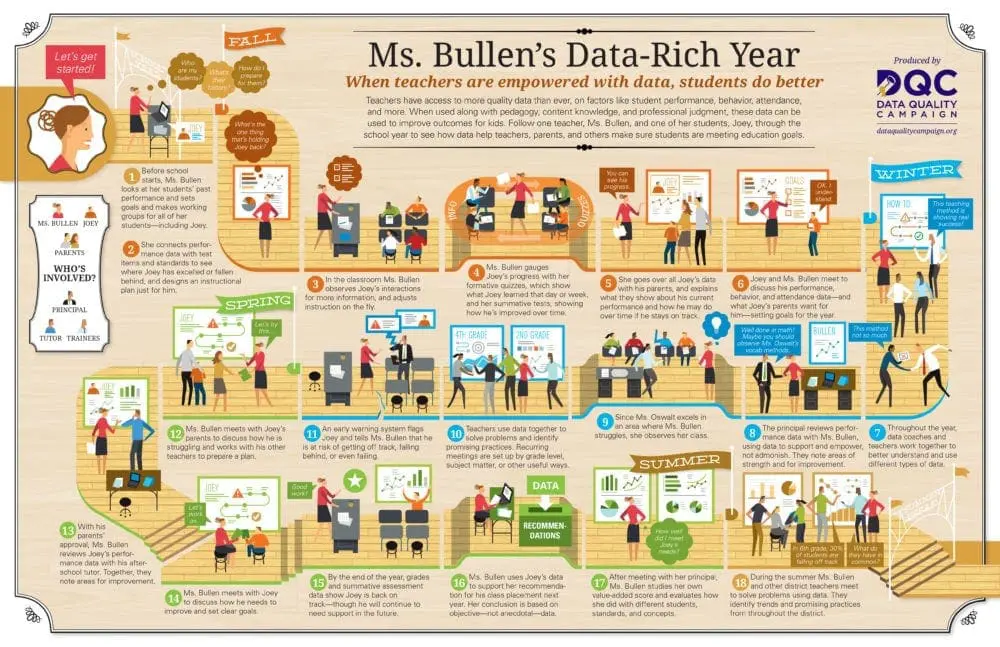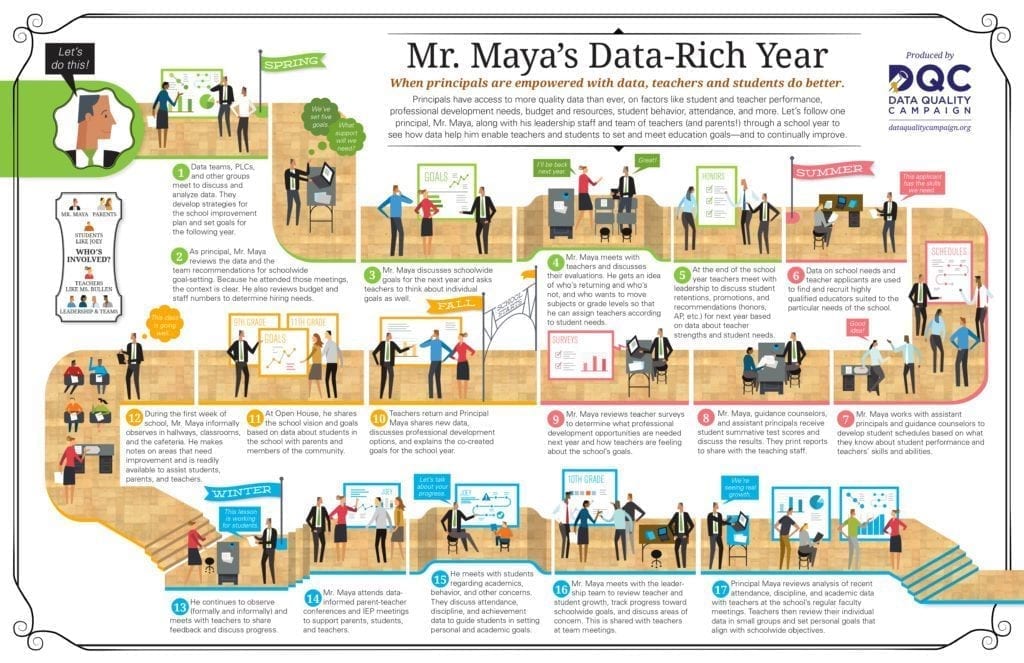Each year, DQC hosts Teacher Data Literacy Week to showcase how students and schools succeed when educators have secure access to meaningful data, and the time and training to use this data effectively. In 2021, we’re focusing on lessons learned about the importance of data and data literacy during the COVID-19 pandemic, and looking forward to how data will drive recovery.
Leaders at every level can use to build their understanding of data literacy, and take action to meet the needs of educators and make data use a more seamless part of the school day and year. Read DQC’s resources ob teacher data literacy below.
What does it mean to be a data-literate educator?
Data-literate educators continuously, effectively, and ethically access, interpret, act on, and communicate multiple types of data from state, local, classroom, and other sources to improve outcomes for students in a manner appropriate to educators’ professional roles and responsibilities.
Why should data literacy be a priority during the COVID-19 era?
With the COVID-19 pandemic shifting schools across the country to online learning models, teachers need to be able to nimbly use the information that is available to them to support student learning. Knowing what to do with that information—how to communicate, marshal resources, and tailor practice to student needs—are the same skills teachers need in a regular classroom setting, but have taken on new urgency during a time of disruption.
Teachers are hungry for data literacy skills, but continue to face obstacles in using data to support student learning. Data literacy skills take time to develop, and are often taught during one-time professional development sessions or self-taught by teachers trying to master these skills on their own. To ensure their students are prepared to meet education and workforce goals in the midst of the COVID-19 crisis, state leaders must act immediately to prioritize strengthening their teacher pipeline with a strong focus on teacher data literacy training. This work is urgent and requires the collaborative efforts of state and local decision makers across the K–12 and higher education sectors.
To date, too few policies and practices demonstrate the importance of supporting teacher data use. When state leaders can focus on not only responding to the crisis, but also deploying lessons learned from this time of disruption to improve education, there are clear action steps that they can take to support teacher data use.
Teacher Data Literacy
What does teacher data literacy look like in action?
Ms. Bullen’s Data-Rich Year follows one teacher throughout the school year as she puts her data literacy skills to work to tailor instruction, engage families, and improve her own practice.

This vision of teacher data literacy has become a reality in many classrooms across the country. In 2019, DQC’s public opinion research found that teachers are actively using data every day to improve student learning and growth:
- 86% use data to help plan instruction
- 88% use data to identify learning goals for students
- 89% use data to know what concepts students are learning
Still, not every classroom is equipped with a data-literate teacher. And while many teachers are putting data to work for their students, most are going above and beyond to do so without the support of administrators and state leaders.
On top of that, teachers are trying to use data to help their students succeed during the unprecedented challenges of the COVID-19 era. In 2020, 46% of teachers said they did not receive trainings or resources about how to assess student learning and progress during school closures. Seventy-eight percent of those teachers said that type of training would have been helpful, and 77% also said that they would like that kind of support in the future.
How can my state better support teacher data literacy?
It takes a village to support student success, and when it comes to data, it’s no different. Teachers shouldn’t have to go it alone. The following recommendations, informed by the opinions of teachers themselves, outline what state leaders can do to better support teachers as they use data:
- Provide teachers with secure access to timely and meaningful student data. In 2020, only 31% of teachers strongly agreed that they had access to the student data they needed (e.g., student test scores and reading-level data) to provide relevant virtual instruction. Eighty-nine percent agreed that they want data about which of their students are furthest behind so that they can provide targeted interventions to get their students back on track for success. In 2019, just 51% of teachers reported that they have access to timely academic growth data.
- Support the creation of one-stop-shop tools that allow teachers to review data nimbly. In 2019, though 65% of teachers reported having centralized, online access to data, only 48% used a central online platform to access it. Nearly half of teachers reported using multiple online or non-centralized sources to access data. States should ensure that getting to data they need is easy for teachers, not cumbersome.
- Ensure that teachers know how to access information from digital resources. As educators are deploying technology to support instruction, their career-long training should make sure that they know how to collect data on the fly—via classroom resources like exit tickets, through formative and summative assessments, and from digital tools.
- Support the development of data literacy skills in educator preparation programs. Most teachers build their data literacy skills while already working at their schools, with 45% reporting in 2019 that they taught themselves during this time. Only 17% of teachers reported learning to use data in their educator preparation program, where teachers are expected to build foundational knowledge that can be applied throughout their careers.
- Work with districts to make teacher data use a more seamless part of the school day. In 2019, a whopping 81% of teachers reported dipping into their personal time to apply student data to their lesson plans and teaching practices. Only 51% agreed that their principal or assistant principal ensures that teachers have the time they need to use data effectively.
- Enable parents to be partners in their student’s learning. Parents also need access to both their student’s day-to-day and longitudinal information in a format that is easy to use and understand. As millions of parents do their best to support their kids while they learn at home, leaders can no longer treat this as a nice to have—it is a necessity.
Administrator Data Literacy
What does administrator data literacy look like in action?
Mr. Maya’s Data-Rich Year follows one principal as he uses data throughout the school year to support student and teacher performance, effectively allocate resources, and create a culture of data use that puts student success at the center.

How can data-literate administrators support teacher data literacy?
Administrators are responsible for creating a culture of effective data use in districts and schools. The following recommendations, informed by the opinions of teachers themselves, outline how administrators can support teacher data literacy in their schools and districts.
- Go beyond stating support for the value of data by modeling data use. In 2019, while 77% of teachers agreed that their principal or assistant principal sets the expectation that using data is an important part of everyone’s job, only 57% agreed these leaders regularly model data use in service of students. Furthermore, just 67% of teachers reported that they trust school administrators to use data to support their professional development and growth.
- Empower teachers with the training needed to become data literate. Only 68% of teachers reported in 2019 that their school or district provides enough professional development around accessing data and 67% reported the same about using data. An even fewer number of teachers (64%) reported that their school or district’s professional development around data use is useful to them.
- Carve out time in the school day for teachers to use data in service of students. In 2019, teachers reported spending more time accessing and prepping data (54%) than analyzing and applying it to their teaching (46%). Despite 46% of teachers stating that principals are most responsible for ensuring time in the school day to use data effectively, only 51% of teachers believe that their school administrator does so.
Resources to Put a Data-Literate Educator in Every Classroom and School
- Teacher Data Literacy: It’s About Time highlights clear recommendations for policymakers to build the conditions and capacity for teachers to become data literate across their careers.
- Roadmap for Educator Licensure Policy Addressing Data Literacy examines the 10 key data literacy skills that states can include in licensure policy, with a focus on effective data use.
- Administrator Data Literacy Fosters Student Success explores how state leaders can use their bully pulpit to align policies and programs that train and support school and district administrators to become data literate and better support data-literate teachers.
- Why I as a Parent Find Data to Be So Important is a story from Jen Martinez, parent and president-elect of the Florida PTA, on the impact a data-literate teacher had in engaging her family in learning outside of the classroom and supporting her child’s success.
- How Temporary Virtual Classrooms Can Help Teachers Better Use Data in Their Real Classrooms is a blog post from Claire Shanahan, a sixth grade English Language Arts teacher and former Data Quality Campaign fellow, on how the COVID-19 crisis and the shift to remote learning have impacted how she uses data to help her students succeed.
- The Potential of Data Use in Uncertain Times: The Role of Positive Data Practices and Cultures offers recommendations from University of Arkansas Professor Kara Lasater to help teachers and leaders implement positive data practices and establish positive data cultures to address the months of unconventional—and likely inequitable—learning experiences that students are experiencing during the COVID-19 crisis.
- To Meet Education and Workforce Goals, States Must Equip Every Classroom with a Data-Literate Teacher charges policymakers with equipping teachers to help students achieve success in K–12 and beyond with secure access to data and the time and training to use this information effectively.
- Giving All Students a Chance at Success in Chicago showcases how teacher data literacy in action in the Windy City put students at the center, reduced drop-out rates, and improved graduation rates.
- Empowering Parents with Data: Nashville’s Data Chats highlights how data-literate teachers use their skills to interpret and communicate information about students’ learning with parents.
- Teachers (and Students) Get Smart with Data in Long Beach shares how prioritizing teacher data literacy equipped educators with the skills needed to use data to reflect on student growth and change instruction in real-time to meet students’ needs.
SOURCES:
Online survey conducted within the United States by The Harris Poll on behalf of the Data Quality Campaign: May 5-14, 2019, among 750 full-time teachers in the U.S., all of whom were currently employed teaching grades K-12.
Online survey conducted within the United States by The Harris Poll on behalf of the Data Quality Campaign: April 27–May 8, 2020, among 750 full-time teachers in the United States, all of whom were currently employed teaching grades K–12.


